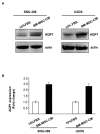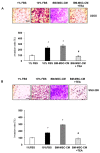Inhibition of AQP1 Hampers Osteosarcoma and Hepatocellular Carcinoma Progression Mediated by Bone Marrow-Derived Mesenchymal Stem Cells
- PMID: 27409610
- PMCID: PMC4964478
- DOI: 10.3390/ijms17071102
Inhibition of AQP1 Hampers Osteosarcoma and Hepatocellular Carcinoma Progression Mediated by Bone Marrow-Derived Mesenchymal Stem Cells
Abstract
The complex cross-talk between tumor cells and their surrounding stromal environment plays a key role in the pathogenesis of cancer. Among several cell types that constitute the tumor stroma, bone marrow-derived mesenchymal stem cells (BM-MSCs) selectively migrate toward the tumor microenvironment and contribute to the active formation of tumor-associated stroma. Therefore, here we elucidate the involvement of BM-MSCs to promote osteosarcoma (OS) and hepatocellular carcinoma (HCC) cells migration and invasion and deepening the role of specific pathways. We analyzed the function of aquaporin 1 (AQP1), a water channel known to promote metastasis and neoangiogenes. AQP1 protein levels were analyzed in OS (U2OS) and HCC (SNU-398) cells exposed to conditioned medium from BM-MSCs. Tumor cell migration and invasion in response to BM-MSC conditioned medium were evaluated through a wound healing assay and Boyden chamber, respectively. The results showed that the AQP1 level was increased in both tumor cell lines after treatment with BM-MSC conditioned medium. Moreover, BM-MSCs-mediated tumor cell migration and invasion were hampered after treatment with AQP1 inhibitor. These data suggest that the recruitment of human BM-MSCs into the tumor microenvironment might cause OS and HCC cell migration and invasion through involvement of AQP1.
Keywords: AQP1; BM-MSCs; hepatocellular carcinoma; invasion; migration; osteosarcoma.
Figures




Similar articles
-
A novel antagonist of CXCR4 prevents bone marrow-derived mesenchymal stem cell-mediated osteosarcoma and hepatocellular carcinoma cell migration and invasion.Cancer Lett. 2016 Jan 1;370(1):100-7. doi: 10.1016/j.canlet.2015.10.018. Epub 2015 Oct 27. Cancer Lett. 2016. PMID: 26517945
-
Bone marrow-derived mesenchymal stem cells promote invasiveness and transendothelial migration of osteosarcoma cells via a mesenchymal to amoeboid transition.Mol Oncol. 2018 May;12(5):659-676. doi: 10.1002/1878-0261.12189. Epub 2018 Mar 31. Mol Oncol. 2018. PMID: 29517849 Free PMC article.
-
Hepatocellular carcinoma cells and their fibrotic microenvironment modulate bone marrow-derived mesenchymal stromal cell migration in vitro and in vivo.Mol Pharm. 2011 Oct 3;8(5):1538-48. doi: 10.1021/mp200137c. Epub 2011 Aug 19. Mol Pharm. 2011. PMID: 21770423
-
Multipotent mesenchymal stromal cells play critical roles in hepatocellular carcinoma initiation, progression and therapy.Mol Cancer. 2018 Dec 28;17(1):178. doi: 10.1186/s12943-018-0926-6. Mol Cancer. 2018. PMID: 30593276 Free PMC article. Review.
-
Tumor microenvironment: bone marrow-mesenchymal stem cells as key players.Biochim Biophys Acta. 2013 Dec;1836(2):321-35. doi: 10.1016/j.bbcan.2013.10.004. Epub 2013 Oct 29. Biochim Biophys Acta. 2013. PMID: 24183942 Review.
Cited by
-
The clinical application of mesenchymal stem cells in liver disease: the current situation and potential future.Ann Transl Med. 2020 Apr;8(8):565. doi: 10.21037/atm.2020.03.218. Ann Transl Med. 2020. PMID: 32775366 Free PMC article. Review.
-
Stem Cell-Induced Cell Motility: A Removable Obstacle on the Way to Safe Therapies?Stem Cells Transl Med. 2022 Mar 3;11(1):26-34. doi: 10.1093/stcltm/szab003. Stem Cells Transl Med. 2022. PMID: 35641164 Free PMC article.
-
Water channel protein AQP1 in cytoplasm is a critical factor in breast cancer local invasion.J Exp Clin Cancer Res. 2023 Feb 20;42(1):49. doi: 10.1186/s13046-023-02616-1. J Exp Clin Cancer Res. 2023. PMID: 36803413 Free PMC article.
-
The Roles of Mesenchymal Stem Cells in Gastrointestinal Cancers.Front Immunol. 2022 Feb 24;13:844001. doi: 10.3389/fimmu.2022.844001. eCollection 2022. Front Immunol. 2022. PMID: 35281017 Free PMC article. Review.
-
Inhibition of carbonic anhydrases IX/XII by SLC-0111 boosts cisplatin effects in hampering head and neck squamous carcinoma cell growth and invasion.J Exp Clin Cancer Res. 2022 Apr 2;41(1):122. doi: 10.1186/s13046-022-02345-x. J Exp Clin Cancer Res. 2022. PMID: 35365193 Free PMC article.
References
-
- Khakoo A.Y., Pati S., Anderson S.A., Reid W., Elshal M.F., Rovira I.I., Nguyen A.T., Malide D., Combs C.A., Hall G., et al. Human mesenchymal stem cells exert potent antitumorigenic effects in a model of Kaposi’s sarcoma. J. Exp. Med. 2006;203:1235–1247. doi: 10.1084/jem.20051921. - DOI - PMC - PubMed
-
- Liu S., Ginestier C., Ou S.J., Clouthier S.G., Patel S.H., Monville F., Korkaya H., Heath A., Dutcher J., Kleer C.G., et al. Breast cancer stem cells are regulated by mesenchymal stem cells through cytokine networks. Cancer Res. 2011;71:614–624. doi: 10.1158/0008-5472.CAN-10-0538. - DOI - PMC - PubMed
-
- Luo J., Ok Lee S., Liang L., Huang C.K., Li L., Wen S., Chang C. Infiltrating bone marrow mesenchymal stem cells increase prostate cancer stem cell population and metastatic ability via secreting cytokines to suppress androgen receptor signaling. Oncogene. 2014;33:2768–2778. doi: 10.1038/onc.2013.233. - DOI - PubMed
MeSH terms
Substances
LinkOut - more resources
Full Text Sources
Other Literature Sources
Medical

